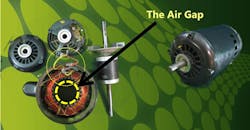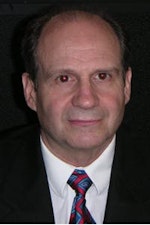The high-energy-product neodymium rare-earth permanent magnet (RE-PM) was discovered in the early 1980s. Later, dysprosium doping emerged to provide reasonable RE-PM magnetization life by sacrificing its precious high energy-product with improved coercivity and higher temperature operation.
Despite ongoing R&D for at least a viable dysprosium alternative, strategically tailoring doping with extremely rare and expensive dysprosium still provides the best permanent magnet for a practical RE-PM electric motor and generator (or electric machine) system (EMS). It’s now considered to be the highest performing (and most expensive) EMS available.
At the time of the discovery of the RE-PM, it was economically viable and provided the allure of eliminating the electrical provisioning and inefficiency of magnetizing magneto-motive-force (MMF). However, virtually all RE-PM R&D was blindly directed to the RE-PM-EMS without considering the environmental issues and political consequences of the RE-PM supply chain.
As supporting evidence, today’s EMS R&D is again blindly directed to awkwardly retrofitting magnetizing MMF into the RE-PM-EMS (for its coveted attribute of controlling air-gap flux density to improve EMS efficiency and reliability at various speeds). It ironically ignores the original intent of eliminating magnetizing MMF already most conveniently provided by the slip-induction EMS that’s being replaced by the RE-PM-EMS.
Supply/Demand Struggle
With ever-increasing application of the RE-PM-EMS, it became evident that the RE-PM global supply chain could not satisfactorily meet demand. Now having strategic ownership of the global neodymium and dysprosium reserves, China controls the continually rising price of RE-PMs and to the chagrin of the original RE-PM R&D investors, China is the de facto manufacturer of the RE-PM-EMS for the foreseeable future.
In response, EMS R&D, such as the 2011 ARPA-E REACT program, is devoted to finding RE-PM alternatives. But after nearly a decade, the results are mixed.
For example, one aspect of the program developed high-frequency electronic control for a higher-speed (with comparable power) and therefore smaller (with less-precious RE-PM material) RE-PM-EMS. However, it seemingly ignored the neutralizing effect of the “compounded” inefficiency, cost, size, and complexity of the necessary transmission addition on the overall system performance. More troubling, the RE-PM-EMS has become the EMS of choice for at least electric vehicles and advanced wind turbines, with “recycling” of RE-PM-EMSs (at the end of their limited magnetization life) as the supply-chain solution.
Long Considered the Best Option
Since at least the 1960s, electric-machine experts have theoretically considered the symmetrical multiphase wound-rotor “synchronous” doubly-fed EMS (S-MWRSDF-EMS) to be the best EMS possible. That’s due to its optimized electromagnetic symmetry of two electrically accessible (i.e., dual ported or doubly fed) balanced multiphase winding sets on each side of the air-gap between the rotor and stator bodies, respectively.
At the time, eliminating the slightest stochastic control dependency on the deoptimizing electromagnetic asymmetry of slip-induction in order to guarantee stable and contiguous “synchronous” doubly-fed control of air-gap flux (for field weakening), speed, torque, and torque angle (for leading-to-lagging power factor) from zero (or sub-synchronous) to super-synchronous speed—particularly in terms of synchronous speed where slip-induction unstably ceases to exist—required the hypothetical invention of a real-time (or instantaneous) emulation (or sensorless and automatic) control means. Such a development was far beyond any technology of the time or even today’s state-of-the-art field-oriented control (FOC).
Unless mechanically damped (as in modern wind-turbine “generator” systems), even the multiphase wound-rotor doubly-fed EMS of today will experience unstable rotor oscillation from the slightest rotor perturbation. This results from at least the “slip-induction” dependency caused by delays and inaccuracies of FOC waveform measurement or synthesis (particularly waveforms with shallow slopes).
Multiphase Slip-Ring-Brush Assembly
In contrast, the multiphase slip-ring-brush assembly and any dependency on stochastic slip-induction can be replaced with a brushless, sensorless, automatic, and instantaneous control means. This will provide perfectly speed-synchronized frequency and phase, bidirectional, smooth, multiphase excitation power “directly” to at least the rotor active multiphase winding set at any speed, including at synchronous speed (as provided by the multiphase brushless real-time emulation control, or BRTEC). SYNCHRO-SYM is today’s only example of a true (and brushless) S-MWRSDF-EMS.
Considering common axial-flux (or pancake motor) RE-PM-EMS footprint electronically controlled by FOC, it’s reasonable to assume that:
• The power rating and associated electrical and core losses are determined by the “active” stator disk (that generates or motors electromechanical power via an active multiphase winding set).
• The physical size and amount (and cost) of materials are similar between the “active” stator disk and the “passive” rotor disk (that dissipates electromechanical power via passive RE-PMs, slip-ring assemblies, reluctance saliencies, field windings, or slip-induction multiphase windings).
• The axial-flux form (with adjacent rotor and stator disks separated by an air-gap instead of the cylinder-inside-cylinder radial flux form) inherently provides winding structural integrity and better performance by avoiding body collision with a smaller air-gap depth (at speeds).
By simply replacing the FOC with BRTEC and replacing the asymmetrical “passive” rotor disk (of RE-PMs) with another “active” stator disk, the resulting SYNCHRO-SYM (with the continuous power rating of two symmetrically accessible “active” winding sets on the stator and rotor disks, respectively) immediately provides at least the conceptually transformational advantages such as:
• Double the power rating without changing the air-gap flux density, the physical footprint, or the packaging techniques of the original axial-flux RE-PM-EMS (or any other retrofitted EMS), such as legacy or future advanced design, material, winding, construction, or manufacturing techniques. This leads to:
- Half the size, weight, or cost (per kilowatt of total power) or twice the power density at half the cost, without including the size, weight, and cost savings from eliminating the expensive, exotic, or wasteful “passive” components, such as RE-PMs.
- Up to half the electrical and core loss (per kilowatt of total power) of the RE-PM-EMS or the copper rotor slip-induction EMS. It includes the electrical loss associated with the electromagnetic core, the small orthogonal vector magnitude of magnetizing MMF, and the much lower compounded system loss associated with the rotor or stator active winding set of SYNCHRO-SYM controlled by BRTEC. Each of the latter is half the total power rating (or one-quarter the I2R electrical loss) of the single stator active winding set of the RE-PM-EMS controlled by FOC.
- Double the performance enhancement (per kilowatt of total power) enabled by the best packaging techniques available to all, which today’s most advanced EMSs are constrained to strategically use on the same century-old “asymmetric” (i.e., passive rotor or single ported) transformer circuit and control architecture for their “fractional” performance enhancement or invention (e.g., square copper wire).
• At least quadruple the peak torque density of the original axial-flux RE-PM-EMS. That’s because in accordance with the classic operating physics of the “symmetric” (or dual-ported) transformer circuit and control architecture (provided by SYNCHRO-SYM), air-gap (and core) flux density remains constant with increasing torque current beyond magnetizing MMF. That’s unlike the alternative passive rotor (or asymmetric) EMS which quickly reaches core flux saturation with increasing torque current.
By retrofitting the RE-PM-EMS (or any EMS) with the circuit and control architecture of SYNCHRO-SYM, significant portions of the limited supply of RE-PMs are saved for other more strategic applications. With twice the power density of comparable RE-PM-EMSs, electric airplanes will fly higher, faster, and longer while reliability will improve! And with at least quadruple the peak torque, electric vehicles will be without the compounded size, weight, cost, unreliability, and inefficiencies of a transmission system for longer battery range.
Moreover, without the safety or assembly issues with the persistent magnetizing of RE-PMs, large, power-stacked, directdrive wind-turbine generators can be componentized into smaller diameter and lighter entities for easy shipping to the given locations.
Fred Klatt is Chief Technology Officer at Best Electric Machine.



